replacement guides for fishing rods

Fishing rod guide replacement is a common maintenance task for anglers. Damaged guides can hinder casting performance and potentially harm fishing line. Understanding the process is key to keeping your rod in top shape.
Common Causes of Guide Damage
Fishing rod guides endure significant wear and tear. Accidental impacts‚ such as dropping the rod or hitting it against hard surfaces‚ are frequent culprits. Improper storage‚ where guides may rub against other objects‚ can also lead to damage. Exposure to saltwater can cause corrosion‚ especially if not cleaned properly. Furthermore‚ constant friction from the fishing line during casting and reeling can gradually wear down the guide’s ceramic insert‚ making it prone to chipping or cracking. These combined factors make guide damage an inevitable part of fishing.

Identifying the Need for Replacement
Recognizing when a fishing rod guide needs replacement is crucial for maintaining optimal performance. Early detection can prevent further damage to your equipment and fishing line.
Signs of Damaged Guides
Several indicators suggest a fishing rod guide requires attention. Look for cracks or chips in the ceramic insert‚ which can cause line damage. A loose or wobbly guide is another telltale sign‚ affecting casting accuracy. Corrosion‚ rust‚ or bent frames indicate damage that impedes smooth line flow. Inspect guides regularly‚ as damage can be subtle at first. Feeling for roughness with a cotton swab is also a good way to check for small cracks. Addressing these issues promptly ensures the longevity of your fishing rod.
Types of Guide Damage
Fishing rod guides suffer various types of damage. Ceramic inserts can crack or chip from impacts or general wear. Guide frames may bend from being dropped or mishandled. Corrosion‚ often due to saltwater exposure‚ weakens the metal components. Sometimes‚ the guide foot‚ the part attached to the rod‚ loosens from the blank. The epoxy holding the guide can break‚ exposing the threads. Regular inspection will reveal if the damage is minor or requires immediate replacement to avoid further problems and line damage.

Tools and Materials for Guide Replacement
Replacing rod guides requires specific tools and materials. Having the correct items ensures a smooth and successful repair. This includes epoxy‚ thread‚ and a guide set.
Essential Tools for the Job
A successful guide replacement requires several essential tools. You’ll need a sharp razor blade or hobby knife to carefully remove old guides. A thread burnishing tool is crucial for smoothing and packing thread wraps. A rod dryer is helpful for even epoxy curing. Additionally‚ a small mixing cup‚ application brushes‚ and masking tape are necessary. Having a good set of precision tweezers to handle the small components is also vital. Finally‚ a lighter or heat gun can aid in thread application and epoxy curing.
Replacement Guide Selection
Choosing the correct replacement guides is crucial for optimal rod performance. Guides come in various sizes‚ frame types‚ and ring materials. Ensure the new guides match the original ones in size‚ especially the inner diameter of the ring. Consider the type of fishing you do; saltwater rods require corrosion-resistant guides. Ceramic rings are common‚ but silicon carbide (SiC) or aluminum oxide offer better performance. The frame material can be stainless steel for durability or titanium for lightness. Always select guides that fit the rod’s original design.
Epoxy and Thread Options
Selecting the right epoxy and thread is vital for a lasting guide repair. Two-part rod building epoxy is preferred‚ offering strength and durability. Choose an epoxy with a suitable working time to allow for adjustments. Thread comes in different materials like nylon or silk‚ with various colors to match your rod’s aesthetics. Size A or D thread is commonly used for guide wrapping. Consider color-preserver for nylon thread to prevent color fade when epoxy is applied. Experiment with different thread colors and patterns to customize your rod. Ensure the epoxy and thread are compatible for the best results.
Step-by-Step Guide Replacement Process
Replacing a fishing rod guide involves several key steps⁚ removing the old guide‚ preparing the rod blank‚ securing the new guide‚ and applying an epoxy finish. Each step is crucial for a successful repair.
Removing the Old Guide
Carefully begin by using a sharp blade or a specialized thread-cutting tool to slice through the existing thread wraps that secure the damaged guide. Be cautious not to damage the rod blank during this process. Once the thread is removed‚ you may need to apply gentle heat from a heat gun or lighter to soften the old epoxy. This will make it easier to slide the old guide off the rod. Any remaining epoxy residue should be carefully scraped away‚ preparing a smooth surface for the new guide.
Preparing the Rod Blank
After removing the old guide‚ it is crucial to properly prepare the rod blank. Carefully inspect the area where the guide was previously attached for any residual epoxy or thread fragments. Use a fine-grit sandpaper or a specialized rod-cleaning tool to gently smooth the surface. Ensure that the rod blank is clean‚ dry‚ and free from any debris. This step is essential for proper adhesion of the new guide and ensures a secure and lasting repair. A clean surface will also help maintain the rod’s overall performance.
Securing the New Guide
With the rod blank prepared‚ carefully position the new guide in its designated spot. Use a small piece of masking tape to temporarily hold the guide in place. Ensure the guide is aligned correctly with other guides on the rod. Begin wrapping the guide foot with thread‚ using consistent tension and overlapping each wrap. The thread should completely cover the guide foot. Once you have a secure wrap‚ double check the alignment before moving to the epoxy application stage. A snug and aligned guide is key.
Applying Epoxy Finish
After the thread wraps are complete and the guide is securely in place‚ it’s time to apply the epoxy finish. Mix the epoxy components carefully according to the manufacturer’s instructions. Use a fine brush to apply a thin‚ even coat of epoxy over the thread wraps. Rotate the rod slowly to ensure the epoxy coats all sides of the thread and guide foot. Check for any bubbles and remove them with a toothpick. Allow the epoxy to cure‚ according to the manufacturer’s instructions. Proper curing will provide a smooth and durable finish.

Tips for Successful Guide Replacement
Successful guide replacement requires careful attention to detail. Proper thread wrapping‚ guide alignment‚ and curing are essential for a durable and functional repair. Taking your time is key.
Proper Thread Wrapping Techniques
Proper thread wrapping is crucial for securing new guides to your fishing rod. Begin with a tight‚ even base wrap‚ ensuring no gaps or overlaps. Use consistent tension and a smooth‚ overlapping pattern as you progress. Overlap each previous wrap by half the thread width to create a smooth‚ even finish; Avoid bunching or loose threads‚ which can weaken the bond. Finish with a secure knot‚ tucking the tag end neatly‚ and ensure the wrap is symmetrical and tight against the guide foot for maximum strength and durability. The right technique ensures a long lasting repair;
Ensuring Alignment of Guides
Proper alignment of guides is paramount for optimal rod performance. Misaligned guides can cause friction‚ reduce casting distance‚ and even damage your line. Before securing the guides‚ use a guide alignment tool or a straight edge to ensure they are in a straight line along the rod blank; Pay particular attention to the guide closest to the reel and the tip-top guide. Double check the alignment both vertically and horizontally. Minor adjustments during the wrapping process can ensure perfect alignment. This attention to detail is critical for your fishing rod’s performance and longevity.
Curing Time and Considerations
After applying the epoxy finish‚ the curing process is essential for a durable and long-lasting repair. Curing time varies based on the type of epoxy used‚ ambient temperature‚ and humidity levels. Generally‚ allow the epoxy to cure for at least 24 hours‚ or as recommended by the manufacturer. Avoid handling or applying pressure to the guides during the curing phase to prevent damage or misalignment. It’s best to cure the rod in a controlled environment‚ away from dust and extreme temperatures‚ ensuring a smooth‚ hard‚ and professional finish to your work. Proper curing is crucial for the integrity of the repair.

Maintenance After Guide Replacement
Regular maintenance is crucial to ensure your replaced guides remain in excellent condition. This includes routine inspections and gentle cleaning to prolong their lifespan and functionality.
Regular Inspection of Guides
After replacing your fishing rod guides‚ it’s essential to implement a routine inspection schedule. This practice helps identify potential issues early before they escalate. Look for signs of wear‚ such as cracks in the ceramic inserts or loose wrappings. Pay close attention to the guide’s alignment and any signs of corrosion. Consistent checks will help maintain the integrity of your repairs and ensure optimal performance‚ preventing further damage and allowing for timely adjustments or re-repairs as needed‚ preserving your rod’s lifespan and effectiveness on the water.
Cleaning and Care of Rod Guides
Maintaining your fishing rod guides after replacement involves regular cleaning and care. After each fishing trip‚ rinse your rod with fresh water to remove salt‚ dirt‚ and grime. Use a soft cloth or brush to gently clean the guides‚ paying special attention to the ceramic inserts. Avoid harsh chemicals that could damage the epoxy or thread. Dry the rod thoroughly before storing it. Proper cleaning and care will prevent corrosion‚ extend the life of your guides‚ and ensure smooth line flow during future fishing sessions‚ contributing to a better overall fishing experience.